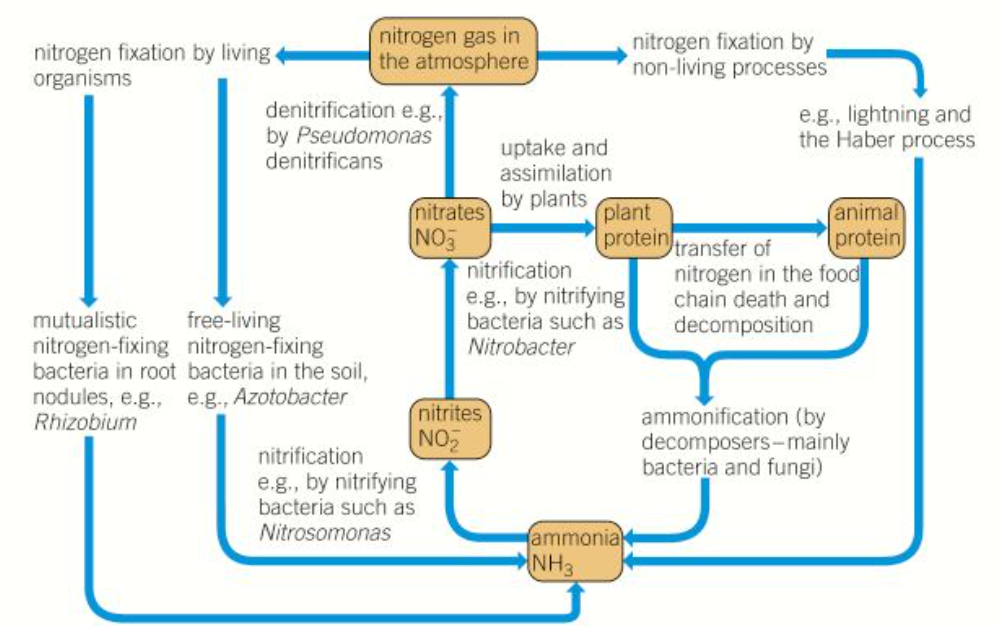Chapter 23 Ecosystems
1/46
There's no tags or description
Looks like no tags are added yet.
Name | Mastery | Learn | Test | Matching | Spaced |
|---|
No study sessions yet.
47 Terms
abiotic factors
light intensity
temperature
water availability
oxygen availability
clay
fine particles
easily waterlogged
forms clumps when wet
loam
different sized particles
retains water
does not waterlog
sand
coarse, well separated particles
does not retain water
energy available units
kJ m-2yr-1
biomass
the mass of living material present in a particular area or in particular organisms
biomass formula
biomass present in each organism x total number of organisms in that trophic level
ecological efficiency
the efficiency in which biomass or energy is transferred from one trophic level to the next
why do producers only convert 1-3% of sunlight they receive into chemical energy
most is reflected
some is transmitted though leaf
some energy lost used for photosynthetic reactions
net production formula
gross production - respiratory losses
why do consumers convert max 10% of biomass to organic tissue
not all biomass of an organism is eaten/ digested
some energy is transferred to the environment as metabolic heat
urine
ecological efficiency formula
(energy available after transfer/ energy available before transfer) x 100
decomposition
chemical process in which a compound is broken down into smaller molecules
saprotrophs
organisms which obtain energy from waste organic material and digest externally by excreting enzymes onto waste matter
detritivores
organisms which speed up decay processes by feeding on dead material and breaking it down into smaller pieces of organic material, increasing surface area
examples of decomposers
microscopic fungi
bacteria
examples of detritivores
woodlice
earthworms
nitrogen fixation
fixing bacteria containing nitrogenase combine atmospheric nitrogen with hydrogen to make ammonia which is absorbed by plants
N2 + 3H2 = 2NH3
Azotobacter
free-living soil bacterium
Rhizobium
bacterium inside root nodules
how do nitrogen-fixing bacteria have a symbiotic relationships with plants
plant gains amino-acids from Rhizobium (produced by fixing nitrogen gas in air into ammonia)
bacteria gain carbohydrates produced by the plant during photosynthesis which they use as an energy source
nitrification
process in which ammonium compounds in soil are converted into nitrogen-containing molecules that can be used by plants. oxidation reaction
steps of nitrifcation
1) nitrifying bacteria (Nitrosomonas) oxidise ammonium compounds into nitrites NO2-
2) Nitrobacter oxidise nitrites into nitrates NO3-
denitrification
denitrifying bacteria convert nitrates in soil back to nitrogen gas. happens under anaerobic conditions
ammonification
process in which decomposers convert nitrogen-containing molecules in dead organisms, faeces, and urine into ammonium compounds
diagram of nitrogen cycle

carbon cycle
removed from environment through photosynthesis
some returned to atmosphere by respiration
some transferred to animals that eat plants
released as decomposers feed on dead plants/ animals
released from combustion of fossil fuels
succession
occurs as a result of changes to the environment (abiotic factors) causing the plant and animal species present to change
primary succession
occurs on newly formed/ exposed land
no soil or organic material present to begin with
secondary succession
occurs on land where soil is present but it contains no plant or animal species
examples of when primary succession takes place
volcanoes erupting creates igneous rock
sand blown by wind to create sand dunes
silt and mud deposited at river estuaries
retreating glaciers deposit rubble and expose rock
seral stages
1) barren land
2) pioneer community (colonisers)
3) intermediate community (secondary colonisers, tertiary colonisers, shrubland)
4) climax community (dominant species)
5) land altered (eg fire, disease, grazing, agriculture)
examples of colonisers
lichen
examples of secondary colonisors
mosses
examples of tertiary colonisers
grasses
examples of shrubland
shrubs
small trees
examples of dominant species
woodland
diagram of seral stages
pioneer species adaptions
able to produce large quantities of seeds/ spores
seeds that germinate rapidly
able to photosynthesise to produce own energy
tolerance to extreme environments
able to fix nitrogen from atmosphere and add to the mineral content of the soil
humus
organic component created when organisms of the pioneer species die and decompose small organic products into the soil
tertiary colonisers adaptations
waxy cuticle to prevent water loss
plagioclimax
stage in which human activities have prevented the ecosystem from reaching a climax community
how does agriculture deflect succession from occuring
grazing of vegetation results in large areas remaining as grassland
removing existing vegetation to plant crops = plant becomes final community
burning to clear forests increases biodiversity = provides space and nutrient-rich ash for other species to grow
estimated number in population m2 formula
number of individuals in sample/ area of sample m2
steps of capture-recapture
1) capture as many individuals as possible in sample area
2) tag each individual
3) release tagged individuals back into sample area and allow time for them to redistribute themselves throughout the habitat
4) recapture as many individuals as possible in the original sample area
5) record the number of tagged and untagged individuals present in the sample
6) use Lincoln index to estimate population size
Lincoln index formula
(number of individuals in first sample x number of individuals in second sample) / number of recaptured marked individuals
Simpson’s Index of Diversity formula
D = 1 - ∑ (n/N)2